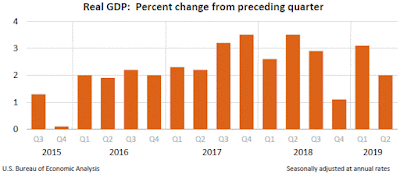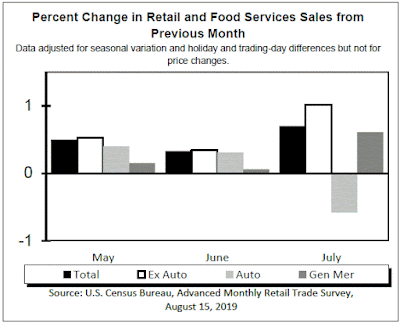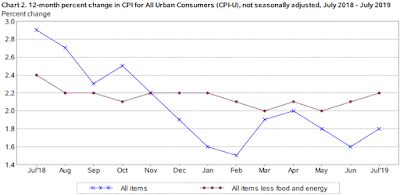Consumer Sentiment: Final Result for August 2019
Predicted: 92.3
Actual: 89.8
- Change from Previous Month: -8.74% (-8.6 points)
- Change from 12 Months Previous: -6.653% (-6.4 points)
=========
- Final ICS Reading for July 2019: 98.4
- Final ICS Reading for August 2018: 96.2
=========
From today's report:
"...The Consumer Sentiment Index posted its largest monthly decline in August 2019 (-8.6 points) since December 2012 (-9.8 points). The 2012 plunge reflected widespread fears of being pushed off the 'fiscal cliff' due to rising taxes and falling government spending. The recent decline is due to negative references to tariffs, which were spontaneously mentioned by one-in-three consumers.
Unlike concerns about the fiscal cliff, which were promptly resolved, Trump’s tariff policies have been subject to repeated reversals amid threats of higher future tariffs. Such tactics may have some merit in negotiations with China, but they act to increase uncertainty and diminish consumer spending at home. Unlike the repeated tariff reversals, negative trends in consumer sentiment cannot be easily reversed. The data indicate that the erosion of consumer confidence due to tariff policies is now well underway.
Compared with those who did not reference tariffs, consumers who made spontaneous negative references to tariffs also voiced higher year-ahead inflation expectations, more frequently expected rising unemployment, and expected smaller annual gains in household incomes (see the chart). While the overall level of sentiment is still consistent with modest gains in consumption, the data nonetheless increased the likelihood that consumers could be pushed off the 'tariff cliff' in the months ahead..."
=========
The ICS is derived from the following five survey questions:
- "We are interested in how people are getting along financially these days. Would you say that you (and your family living there) are better off or worse off financially than you were a year ago?"
- "Now looking ahead, do you think that a year from now you (and your family living there) will be better off financially, or worse off, or just about the same as now?"
- "Now turning to business conditions in the country as a whole, do you think that during the next twelve months we'll have good times financially, or bad times, or what?"
- "Looking ahead, which would you say is more likely: that in the country as a whole we'll have continuous good times during the next five years or so, or that we will have periods of widespread unemployment or depression, or what?"
- "About the big things people buy for their homes, such as furniture, a refrigerator, stove, television, and things like that. Generally speaking, do you think now is a good or bad time for people to buy major household items?"
- Click here for more on how the ICS is calculated.
=========
The ICS uses a 1966 baseline, i.e. for 1966, the ICS = 100. So any number that is below the 1966 baseline of 100 means that the folks who were polled recently aren't as optimistic about the U.S. economy as the sample that was polled back in 1966.
The ICS is similar to the Consumer Confidence Index in that they both measure consumer attitudes and offer valuable insight into consumer spending.
=========
The "predicted" figure is what economists were expecting, while the "actual" is the true or real figure.
=========
=========
Labels: consumer_sentiment, consumers, soft_data
|
--> www.FedPrimeRate.com Privacy Policy <--
> SITEMAP < |















